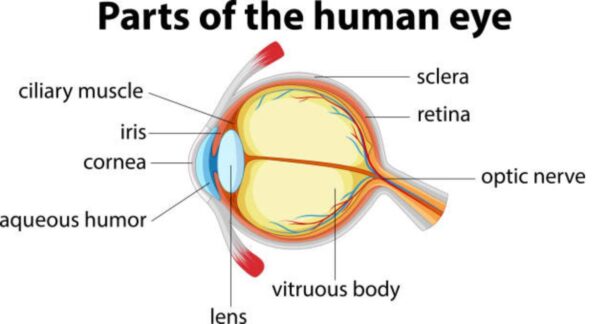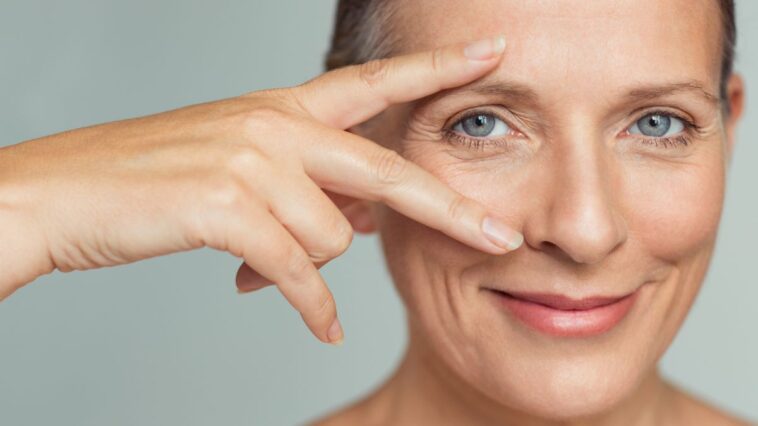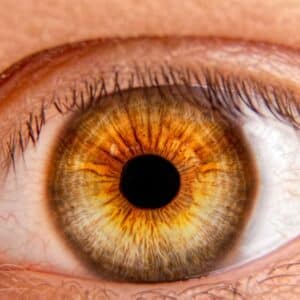When we consider the components of the human eye, the lens, cornea, and retina frequently spring to mind. However, there is another important factor that contributes to the eye’s health and function: aqueous humor. This transparent, watery fluid may not be as well-known as other elements of the eye, but it is critical for maintaining intraocular pressure, supplying nutrition, and eliminating waste. In this comprehensive tutorial, we will examine the function of aqueous humor, its significance for eye health, and the consequences of disrupting its equilibrium.
What is aqueous humor?
Aqueous humor is a clear, gel-like fluid that fills the anterior and posterior chambers of the eyeball. Located between the cornea and lens, it cycles through the pupil, enhancing eye structure and vision. Behind the eye, the ciliary body generates aqueous fluid. By constantly creating and draining this fluid, the eye maintains homeostasis.

Production and Circulation of Aqueous Humor
Understanding how aqueous humor forms and circulates is critical to its function. The ciliary body produces aqueous humor, which flows into the eye’s posterior chamber (the region between the iris and lens). It then passes through the pupil to reach the anterior chamber (the region between the cornea and the iris).
The aqueous humor then drains from the eye via the trabecular meshwork, which is a spongy tissue at the base of the cornea near the iris junction. The fluid exits the eye via Schlemm’s canal, a circular conduit that connects to the bloodstream. This continual production and drainage ensures that intraocular pressure remains ideal, which is critical for the eye’s overall function and health.
Functions of Aqueous Humor
The aqueous humor serves several important functions in preserving the health and functionality of the eye. Let’s look at each of these functions in detail.
1. Maintain intraocular pressure (IOP)
One of the fundamental tasks of the aqueous humor is to maintain intraocular pressure (IOP), which is necessary for the eye’s shape and normal visual function. The aqueous humor’s pressure keeps the eyeball rigid and spherical, allowing light to focus appropriately on the retina.
Intraocular pressure must be within a particular range, usually between 10 and 21 mmHg (millimeters of mercury). If the pressure is too high or too low, it can cause a variety of eye problems. For example, elevated IOP is a significant risk factor for glaucoma, a group of eye diseases that, if left untreated, can result in irreversible vision loss.
2. Providing nutrients for the eye
Another important function of the aqueous humor is to provide nourishment to the eye’s avascular components, such as the lens and cornea. These regions of the eye lack their own blood supply, so they rely on the aqueous humor to transport nutrients such as glucose, amino acids, and vitamins.
These nutrients are essential for maintaining the health and transparency of the lens and cornea, both of which are required for excellent vision. The aqueous humor also helps to remove metabolic waste products from these structures, ensuring their proper performance.
3. Getting rid of waste products
The eye is continually metabolically active, and like any other organ of the body, it creates waste products. The aqueous humor is essential for eliminating waste materials from the eye. As it circulates through the anterior and posterior chambers, the aqueous humor collects waste materials like carbon dioxide and lactic acid, which it then transports away from the eye via the trabecular meshwork and Schlemm’s canal.
This elimination procedure is critical for preventing waste buildup that could harm the eye’s delicate structures. Impeding the drainage of aqueous fluid can lead to an increase in intraocular pressure and subsequent damage to the optic nerve, a condition known as glaucoma.
4. Refracting Light.
The cornea and lens are the primary refractive parts of the eye, but the aqueous humor also plays a small role in refracting light when it enters the eye. The aqueous humor contributes to clear eyesight by maintaining the proper curvature and distance between the cornea and the lens.
5. Immune response.
The aqueous humor contains few immune cells and proteins, which help protect the eye from infections and inflammation. While the eye is considered an immune-privileged location, which means it has a limited immune response to minimize harmful inflammation, the aqueous humor remains the first line of defense against pathogens that may penetrate the eye.
Conditions associated with aqueous humor imbalance
An imbalance in the production or drainage of aqueous humor can cause a variety of eye disorders, many of which can be dangerous if not treated properly.
Glaucoma
Glaucoma is one of the most prevalent and dangerous disorders caused by aqueous humor imbalance. Impaired aqueous fluid drainage leads to an increase in intraocular pressure. Elevated IOP can eventually damage the optic nerve, resulting in vision loss and possibly blindness.
There are numerous forms of glaucoma, the most common being open-angle glaucoma and angle-closure glaucoma, which arise when the drainage angle becomes physically blocked. Both forms have a higher IOP due to reduced aqueous humor outflow; both forms are associated with higher IOP.
Hyphema
Hyphema is a disorder in which blood accumulates in the anterior chamber of the eye, typically due to trauma. This can affect aqueous fluid circulation, increase intraocular pressure, and potentially damage the eye. Hyphema necessitates immediate medical intervention to avoid complications like glaucoma and permanent visual loss.
Uveitis
Uveitis is an inflammation of the uvea, the eye’s central layer, that can disrupt the production and movement of aqueous humor. In severe or chronic uveitis, inflammation can cause scarring and obstruction of the trabecular meshwork, raising intraocular pressure and increasing the risk of glaucoma.
Ocular hypertension
Even though there is no visible damage to the optic nerve or vision loss, ocular hypertension occurs when intraocular pressure rises above normal. People frequently see ocular hypertension as a precursor to glaucoma, and they constantly examine those with ocular hypertension for signs of glaucoma progression.
Fuchs Endothelial Dystrophy
Fuchs’ endothelial dystrophy is a disorder that damages the cornea’s endothelial cells, which are in charge of draining excess fluid from the cornea. When these cells die, it can cause corneal edema and reduced vision. Although this disorder mostly affects the cornea, it can also upset the equilibrium of aqueous fluid in the eye.
Diagnosing aqueous humor imbalances
Early identification of aqueous humor abnormalities is critical for avoiding major vision problems. Regular eye exams are essential because many aqueous humor diseases do not manifest symptoms until they progress.
Tonometry
Tonometry is a diagnostic procedure for measuring intraocular pressure. Most eye exams standardly include tonometry to identify high IOP, which could indicate glaucoma or other issues with aqueous fluid balance.
Gonioscopy
Gonioscopy is a procedure that examines the drainage angle of the eye. It aids in the diagnosis of glaucoma and other disorders that may influence the flow of aqueous fluid.
Optical Coherence Tomography (OCT)
OCT is an imaging test that generates detailed images of the eye’s interior structures, such as the optic nerve, retina, and anterior chamber. It is frequently used to track the impact of glaucoma and other diseases on the eye’s architecture.
Treatment of conditions related to aqueous humor
The therapy and management of aqueous humor disorders frequently focus on restoring the equilibrium between production and drainage.
Medications
We commonly use medications to lower intraocular pressure by reducing aqueous humor production or increasing outflow. This includes:
Beta-blockers stop aqueous humor production.
Prostaglandin analogs: Increase aqueous humor flow.
Carbonic anhydrase inhibitors reduce aqueous humor formation.
Alpha-aagonists: Both reduce production and enhance outflow.
Laser Therapy
Especially in those with open-angle glaucoma, laser therapy improves aqueous humor drainage. Procedures such as laser trabeculoplasty can help to open the trabecular meshwork, allowing for improved aqueous humor drainage.
Surgery
In more advanced cases, surgery may be required to build new drainage channels for the aqueous fluid. To achieve this, trabeculectomy and drainage implant implantation are two popular procedures.
Preventing aqueous humor imbalances
Preventive therapy is critical for keeping aqueous humor healthy and preventing problems like glaucoma. Regular eye checkups, positive lifestyle choices, and addressing underlying health issues such as diabetes and hypertension can all help to keep the aqueous humor in balance.
Conclusion
The aqueous humor may not be as well known as other eye elements, but its role in preserving eye health is critical. The activities of aqueous humor, which include maintaining intraocular pressure and delivering needed nutrients, are critical to our ability to see well.
Understanding its importance and detecting indicators of imbalance allows us to take proactive efforts to protect our eyesight and keep our eyes healthy for years to come. Regular eye exams and early intervention are critical in avoiding and controlling aqueous humor-related diseases, ensuring that this key fluid continues to maintain our vision throughout our lifetime.






